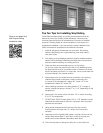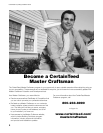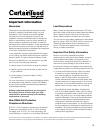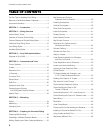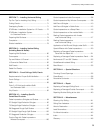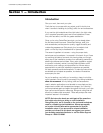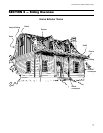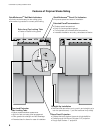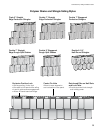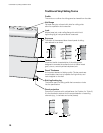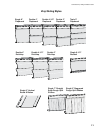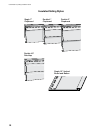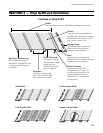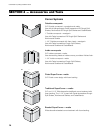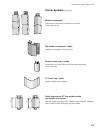
CertainTeed Vinyl Siding Installation Guide
3
Important Information
Warranties
These instructions describe and illustrate the steps
involved in installing CertainTeed siding, trim, and
accessories. Their purpose is to provide detailed
information and how-to tips that will simplify the
installation process. CertainTeed shall not accept any
liability or responsibility under its written warranty for
failure caused by application that does not meet the
requirements for proper installation. These requirements
are outlined throughout this book. Any deviations from
these requirements should be addressed and approved
in writing by CertainTeed Corporation.
In rare instances, intense sunlight reflected from glass
on vinyl siding may create heat buildup and cause the
siding to distort. To help minimize the effects of heat
buildup from reflected sun, the homeowner may take
one or more of the following measures:
• Install a screen in the window causing the problem.
• Install an awning over the window to break the line
of light reflection.
• Use shrubbery to protect the area of siding
from reflections.
For more information on the potential damaging effects
of concentrated solar reflection, visit the VSI website
at http://www.vinylsiding.org/aboutsiding/cleanmain/
solarandheat/index.asp
Building codes and regulations vary throughout
the country. Be sure to check with your local
code official or governing body for the building
requirements in your area.
New OSHA Fall Protection
Compliance Directives
STD 03-11-002 Compliance Guidance for Residential
Construction was issued on Dec. 6, 2010 and went
into effect June 16, 2011. For more information visit
www.OSHA.gov or consult your local State OSHA plan.
Lead Renovations
Many houses and apartments built before 1978 have
paint that contains high levels of lead (called lead-based
paint). Lead from paint, chips, and dust can pose
serious health hazards if not taken care of properly.
You can find out about safety measures for lead-based
paint by calling 1-800-424-LEAD. Ask for the brochure
“Reducing Lead Hazards When Remodeling Your
Home.” That brochure explains what to do before,
during, and after renovations.
Important Fire Safety Information
Exterior vinyl building materials require little
maintenance for many years. Nevertheless, common
sense dictates that builders and suppliers of vinyl
products store, handle and install vinyl materials in a
manner that avoids damage to the product and/or
the structure. Owners and installers should take a few
simple steps to protect vinyl building materials from fire:
• To Home and Building Owners: Rigid vinyl siding
is made from organic materials and will melt or
burn when exposed to a significant source of
flame or heat. Building owners, occupants and
outside maintenance personnel should always take
normal precautions to keep sources of fire, such as
barbecues, and combustible materials, such as dry
leaves, mulch and trash, away from vinyl siding.
• To the Building Trades, Specifiers, Professionals
and Do-It-Yourself Installers: When rigid vinyl siding
is exposed to significant heat or flame, the vinyl will
soften, sag, melt or burn, and may thereby expose
material underneath. Care must be exercised when
selecting underlayment materials because many
underlayment materials are made from organic
materials that are combustible. You should ascertain
the fire properties of underlayment materials prior to
installation. All building materials should be installed
in accordance with local, state and federal building
codes and fire regulations.
This manual shows the basic guidelines for installation. It is based on ASTM (American Society for Testing and Materials) D4756, the standard
practice for installation of vinyl siding and soffit. Additionally, we recommend that local building codes be reviewed.




